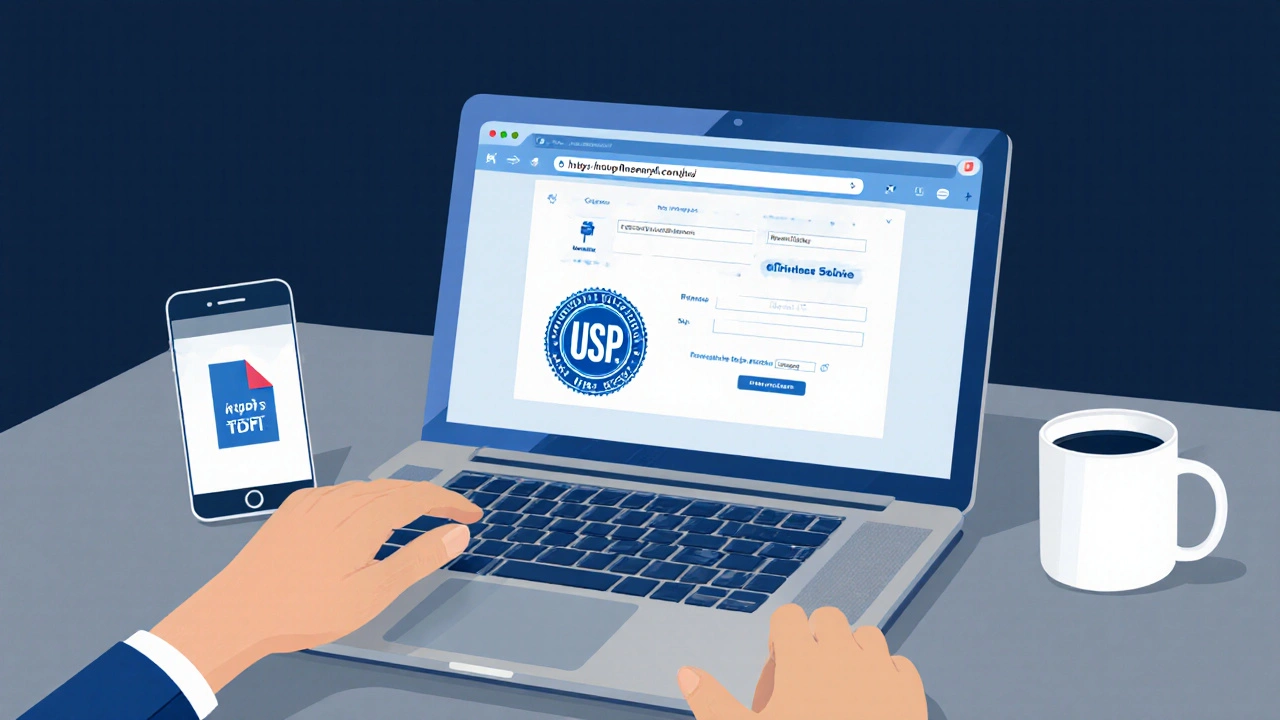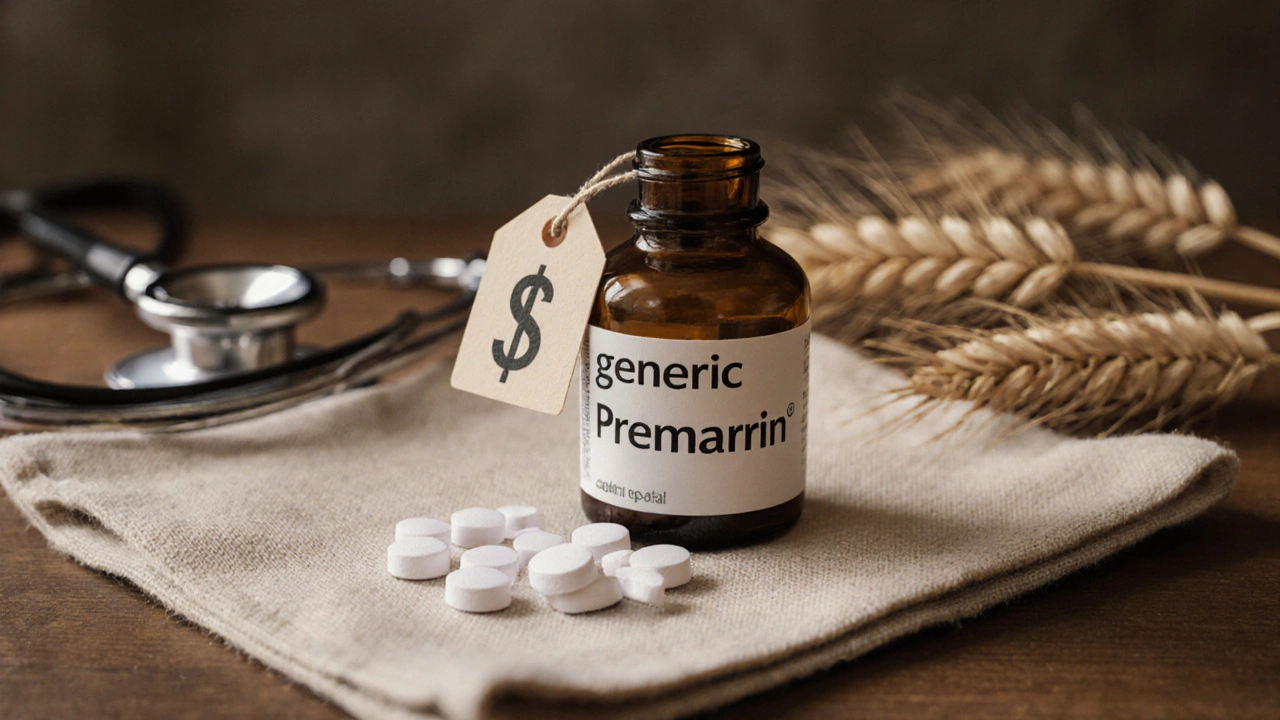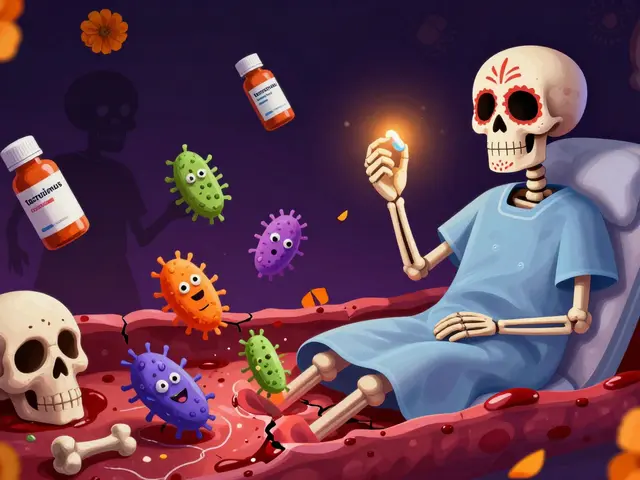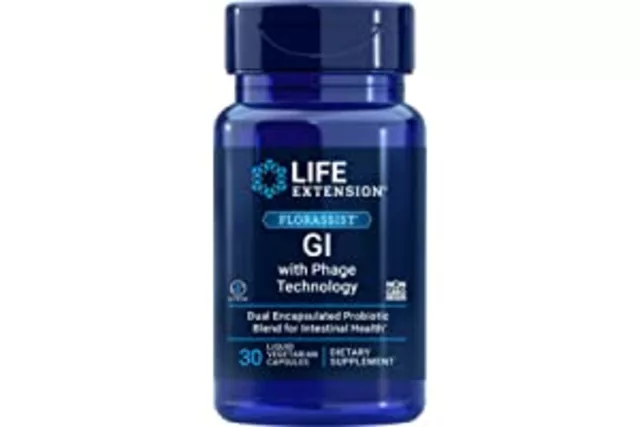When you need estrogen therapy but don’t want to break the bank, finding a cheap generic Premarin online feels like hunting for a needle in a haystack. Below you’ll get a straight‑forward roadmap: what the drug does, why a generic version can save you money, how to spot a safe online pharmacy, and the exact steps to place an order without risking your health.
What Is Generic Premarin?
Generic Premarin is a synthetic mixture of conjugated estrogens derived from pregnant mare’s urine, used to treat menopausal symptoms, prevent osteoporosis, and manage certain hormonal deficiencies. It contains the same active ingredients as the brand‑name product Premarin, but manufacturers are not required to repeat costly clinical trials, which drives the price down.
The drug typically comes in 0.3mg, 0.6mg, or 1.25mg tablets. Doctors prescribe it for hot flashes, night sweats, vaginal dryness, and to support bone density during menopause.
Why Go Generic?
- Cost: Generic versions cost roughly 30‑50% less per milligram compared with the brand.
- Regulation: In the United States, the FDA ensures bioequivalence and safety for all approved generics, so you’re not sacrificing quality.
- Availability: Many certified online pharmacies stock generic Premarin in bulk, which further reduces the per‑tablet price.
How to Verify a Safe Online Pharmacy
Buying hormone therapy over the internet is risky if you don’t know who you’re dealing with. Follow this safety checklist before you click “Add to Cart.”
- Check for a valid US Pharmacopeia (USP) seal or accreditation that guarantees drug quality logo on the site.
- Make sure the pharmacy asks for a prescription from a licensed healthcare provider. Any site that sells “no‑prescription” estrogen is a red flag.
- Look for a physical address and a reachable phone number. Fraudulent sites often hide contact info.
- Verify that the pharmacy is listed in the National Association of Boards of Pharmacy (NABP) Verified Internet Pharmacy Practice Sites (VIPPS) program. A VIPPS seal is a reliable indicator of compliance.
- Read recent customer reviews that mention delivery speed, packaging, and whether the tablets matched the prescribed strength.
Price Comparison: Generic Premarin vs Brand Premarin vs Other Estrogen Options
| Product | Typical Dose (mg) | Average Price per Tablet | Formulation | Prescription Required |
|---|---|---|---|---|
| Generic Premarin | 0.3-1.25 | $0.25-$0.45 | Conjugated estrogens (horse‑derived) | Yes |
| Premarin (brand) | 0.3-1.25 | $0.80-$1.10 | Conjugated estrogens (horse‑derived) | Yes |
| Estradiol Oral (generic) | 1-2 | $0.30-$0.55 | Estradiol (synthetic) | Yes |
| Transdermal Estradiol Patch | 0.025mg/day | $2.00-$3.00 per patch | Estradiol (synthetic) | Yes |

Step‑by‑Step: Ordering Generic Premarin Online Safely
- Obtain a prescription. Schedule a telehealth visit or see your OB‑GYN. The doctor will specify the dose (e.g., 0.6mg daily).
- Save the prescription as a PDF or JPG. Most reputable sites let you upload it securely.
- Visit a verified pharmacy that passed the safety checklist above. Examples (as of 2025) include HealthWarehouse, Blink Health, and Canada‑based Canada Pharmacy - all carry the VIPPS seal.
- Select the exact strength and quantity. Many users buy a 90‑day supply to lock in a lower per‑tablet price.
- Enter your shipping address and payment details. Credit cards or PayPal offer additional buyer protection.
- Review the order summary. Confirm that the product name, dosage, and price match what you expect.
- Place the order. Expect delivery within 3‑7 business days for US locations, 5‑10 days for Canada‑origin shipments.
- Upon receipt, check the packaging for tamper‑evident seals and compare the batch number with the prescription.
If anything looks off-missing batch number, wrong tablet size, or a different brand-contact the pharmacy immediately and consider refusing the package.
Common Concerns & How to Address Them
Is it legal to buy Premarin online? Yes, as long as the pharmacy is licensed, requires a prescription, and ships the medication within the United States. Importing drugs from abroad without FDA approval is illegal.
Will a generic work the same as Premarin? Clinical studies show that generic conjugated estrogens achieve the same blood‑level curves as the brand, which translates to similar symptom relief.
What about side effects? The most frequent are mild nausea, breast tenderness, and occasional headaches. Rare but serious risks-blood clots, stroke, gallbladder disease-are why a doctor‑supervised prescription is non‑negotiable.
Can I get insurance coverage? Some plans reimburse the cost of generic estrogen therapy. Submit the pharmacy invoice with your prescription to your insurer for potential partial reimbursement.
Red Flags to Avoid Scams
- Websites offering “no‑prescription” estrogen for under $5 a month.
- Pharmacies that only accept cryptocurrency or cash on delivery.
- Unsecured website URLs (no https).
- Emails that claim you’re eligible for a free trial of Premarin without a medical record.
If a deal looks too good to be true, it probably is. Stick to the vetted list, and you’ll avoid counterfeit pills that could be ineffective or dangerous.
What to Do After Your First Fill
Start the medication exactly as your prescriber instructed-usually once daily with food to reduce nausea. Keep a symptom diary for the first two weeks: note hot flashes, mood changes, and any side effects. Bring this record to your follow‑up appointment (typically after 4-6 weeks) so the doctor can adjust dosage if needed.
Most people find relief within 7‑10 days, but full benefits for bone health may take several months. Consistency is key; missing doses can cause hormone fluctuations that worsen symptoms.

Frequently Asked Questions
Can I purchase generic Premarin without a US prescription?
No. US law requires a valid prescription for any estrogen product, generic or brand. Some foreign pharmacies claim to bypass this rule, but buying that way is illegal and risky.
How much does generic Premarin cost per month?
For a typical 0.6mg daily dose, the per‑tablet price ranges from $0.25 to $0.45. A 30‑day supply therefore costs between $7.50 and $13.50, far cheaper than the brand’s $24‑$35 range.
Is it safe to take generic Premarin long‑term?
Long‑term use is safe when monitored by a healthcare professional. Regular check‑ups (every 6‑12 months) assess bone density, cardiovascular health, and any signs of clotting issues.
What should I do if I receive the wrong strength?
Contact the pharmacy immediately, refuse the package if you haven’t opened it, and request a replacement. Keep the original packaging for evidence.
Are there any natural alternatives to Premarin?
Phytoestrogen‑rich foods (soy, flaxseed) can offer mild relief, but they rarely match the potency of prescription estrogen. Discuss any supplement use with your doctor to avoid interactions.








7 Comments
Michelle Zhao October 4, 2025
It is utterly astonishing how often the market for estrogen therapies is portrayed as a simple price‑comparison exercise, as if the chemistry and regulatory oversight were mere footnotes. While the author extols the virtues of generic Premarin, the narrative conveniently sidesteps the nuanced pharmacovigilance that accompanies hormone replacement. One must remember that the raw material, conjugated estrogens derived from equine urine, carries its own batch‑to‑batch variability, a fact seldom highlighted in marketing copy. Moreover, the claim that “generic versions are bioequivalent” rests on a narrow set of pharmacokinetic endpoints, ignoring individual metabolic idiosyncrasies. The safety checklist, albeit thorough, presumes that the average consumer will meticulously verify USP seals and VIPPS accreditation, an expectation that borders on unrealistic. In a contrarian vein, I would argue that the cheapest option is not always the most prudent, especially when long‑term cardiovascular risk looms. The article’s tone, while earnest, feels like a subtle endorsement rather than a balanced appraisal. Patients with a history of thromboembolic events, for instance, deserve a more cautious discourse than a straightforward checklist. Additionally, the emphasis on bulk purchasing may unintentionally encourage stockpiling, which can lead to medication wastage and confusion over expiration dates. The omission of discussion about potential drug‑drug interactions with common antihypertensives leaves a gap in the guidance. While the step‑by‑step ordering guide is helpful, it fails to address the legal ramifications of importing from Canadian pharmacies for those residing in states with restrictive compounding laws. The risk of counterfeit pills, though mentioned, could be expanded to include the role of online review manipulation. A thorough examination would also compare the environmental impact of horse‑derived estrogen production versus synthetic alternatives. Finally, the article could benefit from a more critical lens on the pharmaceutical industry's pricing strategies that perpetuate the very “high cost” problem it seeks to solve. In sum, enthusiasm for affordability must be tempered with vigilance, lest patients trade cost savings for unforeseen health hazards.
Eric Parsons October 17, 2025
From a philosophical standpoint, the decision to purchase medication online touches on autonomy and trust in the healthcare system. Practically, verifying the pharmacy’s certification is the first safeguard, followed by confirming the exact dosage prescribed. It is also worthwhile to compare the cost per milligram rather than per tablet, as strengths differ. Consistent with best practices, keep a copy of the prescription handy for any future pharmacist inquiries. Ultimately, an informed patient is empowered to balance affordability with safety.
Mary Magdalen October 29, 2025
The American market shouldn’t have to rely on horse‑derived concoctions while overseas vendors hawk cheaper knock‑offs. Our regulators are strict, yet some foreign sites poison the system with substandard batches. When you see a “$4 a month” deal, ask who’s profiting and at what cost to domestic manufacturers. Vigilance protects not just your health but our national pharma integrity.
Dhakad rahul November 10, 2025
Behold, the miracle of a discount that seems blessed by the commerce gods! 🤩 Yet remember, drama fades when the seal is missing.
William Dizon November 22, 2025
Hey folks, just a quick heads‑up: always double‑check that the pharmacy’s address matches the one listed on the NABP site. If the logo looks off, it’s better to walk away than risk counterfeit pills. A little extra time now saves a lot of trouble later.
Jenae Bauer December 5, 2025
Some say the cheap generic is a blessing, but what if the real agenda is to monitor who orders hormones online? The push for “no‑prescription” sites could be a test of our digital compliance. I’m not saying it’s definitely a plot, just that we should stay skeptical. After all, knowledge is the best antidote.
vijay sainath December 17, 2025
Look, the numbers don’t lie – a 0.3 mg tablet at $0.30 is a steal compared to the brand’s $0.90. If you’re not comparing per‑milligram prices, you’re doing it wrong. Also, those “VIPPS” seals are just logos; the real test is the batch analysis report.